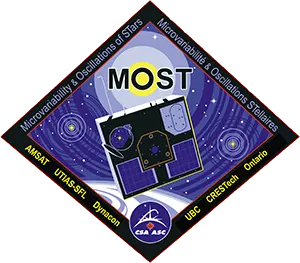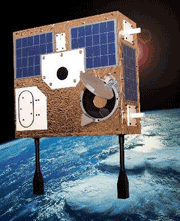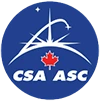MOST
Canada’s First Space Telescope



The MOST (Microvariability and Oscillations of STars) astronomy mission under the Canadian Space Agency’s Small Payloads Program is Canada’s first space science microsatellite and Canada’s first space telescope. MOST was successfully launched 30 June 2003 on a “Rockot” launch vehicle from Plesetsk, Russia.
The satellite’s mission is to conduct long-duration stellar photometry observations in space. The primary science objectives include measuring light intensity oscillations in solar type stars; determining the age of nearby “metal-poor sub-dwarf” stars, which in turn allows a lower limit to be set on the age of the Universe; and detecting the first reflected light from orbiting exoplanets and using it to determine the composition of their atmospheres.
To make these measurements, MOST incorporates into a microsatellite design a small (15-cm aperture) high-photometric-precision optical telescope and a high-performance attitude control system that is revolutionary in its pointing accuracy for a microsatellite. The satellite was commissioned during the first few months after launch and is now in science operations mode, exceeding performance predictions.
SFL developed the structure, thermal, on-board computers and telemetry & command systems, along with the ground stations, and directed the spacecraft integration and test effort. Led by Dr. Robert E. Zee, SFL played a critical role in the launch campaign, commissioning and operation of the satellite. SFL received direct mentoring from AMSAT North America (AMSAT-NA), with support from AeroAstro.
In affiliation with AMSAT-NA, the design approach used in AMSAT’s Microsat series of satellites was adapted for use by MOST. SFL also established facilities to support the development of microspace missions, such as computing facilities, assembly, integration and test facilities, three-axis motion table for attitude control testing, microsatellite simulators, thermal cycle and vacuum chambers, clean room, and ground stations to operate these missions.
Three ground stations in Toronto, Vancouver and Vienna are used to download data from MOST. The primary control station is in Toronto, while the secondary stations (Vancouver and Vienna) are controlled and coordinated over the Internet. Although the basic mission can be accomplished with just one ground station, additional science data can be acquired using the secondary stations.
The stations used for MOST communications are based on an amateur radio core station operating at VHF and UHF frequencies. They are upgraded with S-band transverters and BPSK transceivers connected to a 2-m parabolic antenna (downlink) and a 45-element loop yagi (uplink). The antennas are mounted on a heavy-duty, precisely controlled rotator located atop a 20-foot tower.
Until recently, performing optical astronomy experiments from a low-cost microsatellite (mass < 100 kg) was considered infeasible because of the poor pointing possible from a platform with such small inertia (approx. ± 2°). In 1997, anticipating new microsat attitude control technology, a team of astronomers and aerospace engineers first proposed to the Canadian Space Agency (CSA) a project to obtain astronomical photometry of unprecedented precision from a microsatellite. In the next year, MOST (Microvariablity and Oscillations of STars / Microvariabilité et Oscillations STellaire) was selected to be Canada’s first science microsat, as part of the CSA Small Payloads Program. Additional funding was provided by the Ontario Research and Development Challenge Fund, the Natural Sciences and Engineering Reseach Council (NSERC), the Ontario Centre for Research in Earth and Space Technology and the Universities of Toronto, British Columbia and Vienna.
This science team led by Professor Jaymie Matthews of the Department of Physics and Astronomy at the University of British Columbia (UBC) developed the mission’s detailed science requirements, as well as new theoretical stellar models to exploit photometric data whose precision is two orders of magnitude better than what has been possible from the ground.
Dr. Matthews also led a team of optical, mechanical and electronics engineers at UBC responsible for the design and construction of the instrument, with assistance of the Ontario Centre for Earth and Environmental Technologies (ETech), which has expertise in structural design and instrument testing.
MOST is the first instrument in history capable of detecting these signals and giving direct information about the atmospheres of these mysterious worlds. At the same time, data on the oscillations of the parent stars specify the ages of these stellar/planetary systems – an important test of models of how these planets formed and evolved.
Funding Partners



